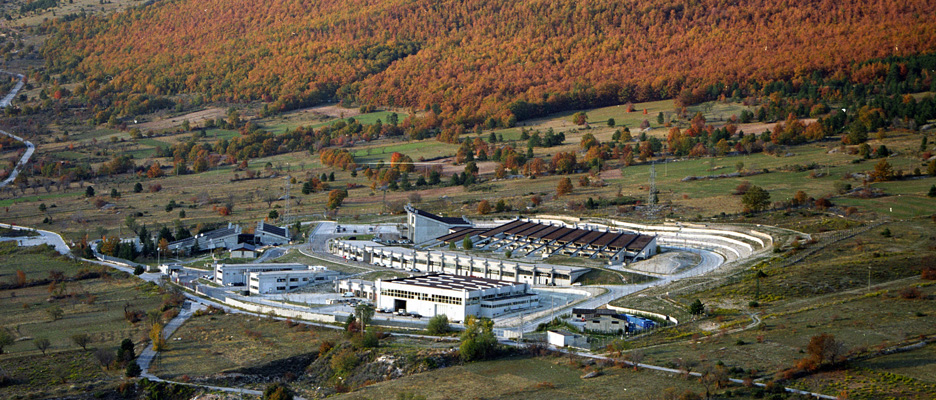Cal Poly Physics Professor Thomas Gutierrez leads research into neutrinos at underground lab

ASSERGI, Italy – In a research lab under almost a mile of rock and a six-centimeter-thick shield created from boiled-down lead from an ancient Roman shipwreck, physicists are observing a rare form of nuclear decay to answer perhaps the biggest question in all of physics, not why but how are we here?
"Under the laws of physics, there should have been equal amounts of matter and antimatter, and they should have all annihilated, gone away, and we shouldn’t exist," ominously details California Polytechnic State University physics Professor Thomas Gutierrez. "Yet this little sliver of matter that got left over is us. Why do we even exist? Why is that sliver there at all? So that’s kind of a puzzle."
Professor Gutierrez is the principal investigator of a $340,000 three-year grant from the National Science Foundation to solve that very puzzle.

He joins more than 150 international researchers working through the Gran Sasso National Laboratory near Assergi, Italy beneath the Appenine Mountains.
The facility is the largest underground laboratory devoted to neutrino and astroparticle physics in the world explained a press release from California Polytechnic State University.

Dr. Gutierrez and his student researchers are specifically looking into a particular version of radioactive decay that does not produce neutrinos, which are the Cal Poly Professor's area of expertise.
Radioactive elements, highlighted in yellow in the image below, discharge energy over time until they become a different, stable element.

That process of discharging energy, turning into other radioactive elements, and eventually stopping as a stable, non-radioactive element is called the decay chain and is unique to each radioactive element.
Also discharged during the decay chain are tiny particles with an extremely slight mass and a neutral charge known as neutrinos.
Neutrinos are the most abundant particles that have mass in the universe and are produced when atoms come together, known as fusion, or break apart, a process known as fission, explains the U.S. Department of Energy.
Physicists predicted the existence of the tiny particles in 1930, but because of how limited their interactions are with other matter, it took another 26 years to detect them.
The process to detect them is very delicate, very sensitive, and requires extremely low temperatures, hence the laboratory conditions described at the beginning of this article.
In fact, the temperatures used are around 10 millikelvin, or -441.74 degrees Fahrenheit, the coldest volume of its size anywhere in the universe detailed Cal Poly.
Those cold temperatures cause the particles the scientists are looking at to move slower, allowing easier and more accurate observations of their behaviors.
Dr. Gutierrez's research continues a previous international collaboration known as the Cryogenic Underground Observatory for Rare Events, or CUORE, program that was searching for a very particular type of radioactive decay known as neutrinoless double beta decay.
During neutrinoless double beta decay, an atomic nucleus releases two electrons but no neutrinos.
Wait, this article said earlier that neutrinos are produced during radioactive decay, how can this type of decay be neutrinoless?
Great question! That mystery is exactly what researchers are trying to find out.
Modern physics states that all particles have antiparticles or their own antimatter counterpart, and when they meet, they annihilate each other and produce energy.
Finding a form of radioactive decay where neutrinos are not produced may prove that the tiny particles act as their own antiparticles. According to this Stanford experiment, other particles may serve as their own antiparticle as well.
"If neutrinoless double beta decay happens, it tells us all this information about the foundations of how matter — not just this matter, but all matter — exists," explained Professor Gutierrez. "We’re looking for a type of nuclear decay that is currently forbidden by the (existing) laws of physics. It’s not supposed to happen. So, if it does — which is what we’re looking for — it tells you a lot about the way the world works."
So the international science team are focusing their search for neutrinoless decay on tellurium dioxide crystals which are a mix of tellurium and oxygen.
"There is a hypothesis that a tellurium isotope can undergo a neutrinoless double beta decay." shared Dr. Gutierrez. "The idea is to use a detector out of this crystal where it measures its own decay...It will deposit a very certain amount of energy, raising the temperature, which we can observe. Through this testing, in a best-case scenario, what we’d like to be able to say is whether or not the neutrino is its own antiparticle."
